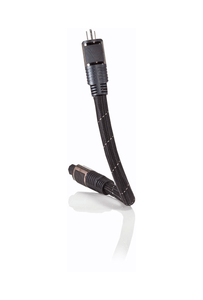
PS-Audio - PerfectWave AC5 Power Cable
The PerfectWave AC5 is the best value power cable we’ve made in the last decade. The AC5 is a 10 gauge cable constructed with pure Linear Crystal Copper in multiple gauges and shapes. Inside the AC5 is one LCC hollow conductor for the treble region, a large LCC rectangular conductor for the midrange and multiple gauges of LCC bundled together for the bass. Equipment powered with an AC5 enjoy a significant improvement in sound quality over any stock power cable.
- Linear Crystal long grain Copper
- 10 gauge power cable
- Double shielded
- Hollow tube conductors for treble performance
- Rectangular conductors for midrange performance
- Multiple gauge conductors for bass performance
- Nickel plated connectors
- Welded connector to conductor
The PerfectWave AC5 is the best selling power cable we’ve made in the last decade.
The low noise, high-speed design of the AC5 is based on 5 patents and years of listening and engineering and we believe it will bring new levels of refined beauty, power and spacious performance to high-end systems that use it.
AC power is a critical element in any high-performance audio/video system. Delivering that power to your equipment, without loss, is the job of the AC power cable.
A bit of history
In early 2000 we introduced the Lab Cable power cord. The Lab Cable was one of the first aftermarket high-end power cables produced and it helped ignite a revolution in AC power interest that continues through today.
The Lab Cable was a major improvement over the stock power cable supplied with the equipment. The main benefits of the Lab Cable are still embodied in today’s high-end cables: significant shielding from outside noise, internal geometries that reduce complex load interactions, heavier wire gauge to reduce power drops and the use of superior conducting materials.
It’s all in the design and construction
A stock power cable is something manufacturers purchase in large volumes from the lowest cost vendors and include in their products as a courtesy. These power cables will always be adequate in terms of power delivery but rarely designed to take advantage of all the performance values the equipment is capable of.
When choosing a power cable for connected equipment it is important to select a model with adequate shielding, proper materials and well designed connectors that are up to the task at hand.
The PS Audio PerfectWave AC5 an excellent type of power delivery system needed for any high-end audio or video equipment.
The AC5
The PerfectWave AC5 represents our best achievement in the art of affordable power cable construction practiced over the last decade.
The AC5 is a 10 gauge pure Linear Crystal Copper cable constructed in multiple gauges and shapes. Inside the AC5 is one hollow LCC conductor for the treble regions, one massive LCC rectangular conductor for the midrange and multiple gauges of LCC bundled together for the bass. The results of these design decisions is something rewarding to experience.
Use the AC5 in any high-end audio application: between the wall or Power Plant and your power amplifier, preamplifier, DAC or phono preamplifier. Once connected via the AC5 you’ll most likely notice that the soundstage opens up in ways you didn’t realize your system was capable of because of its stock power cable.
The design of the AC5
The performance goals for the AC5 focus on building a musically balanced cable, specifically targeting the three main tonal areas of music: bass, midrange and treble.
The balance between these three core areas is achieved by a combination of conductor shape, materials and geometry. The exact formulation for each of the models is designed by careful listening and evaluation engineering, but based on some of the principals contained in several patents, chief among them 6,969,805 of the US patent office and licensed to PS Audio by the inventor.
The patent describes an elegant solution to managing tonal characteristics of the reproduced audio by leveraging the properties of shaped conductors; specifically square for midrange and a thin flat conductor for the treble.
Shielding
Shielding a cable utilizes conductors around the entire cable to pickup any electrical noise from within and from outside the cable. This is important because the equipment generates noise on the power line which is injurious to surrounding equipment as well as keeping extraneous noise from getting into the power cable. Good shielding is a requirement for any power cable in a high-end system.
The AC5 employs a dual shield for great low noise performance. This level of shielding lowers the noise of connected equipment to much quieter levels.
Conductors
One of the critical considerations in a high-performance power cable is the grade of copper. The conductivity of the conductors plays a significant role in extracting the best sound out of your system through better power cable construction. In the AC5 we use a pure, single crystal copper known as Linear Crystal Copper.
Copper typically has millions of crystals connected together to form the strand we use to deliver power. Between each crystal structure is a small semiconductor barrier that the flow of electrons must overcome to deliver current at the other end.
Linear Crystal Copper improves this problem by creating longer grains of copper with fewer barriers than standard copper conductors.
Connectors
As early as 2003 we realized that even with the best conductor technology in the world would benefit from an improved connector.
The PerfectWave AC5 connectors are built out of a solid block of high copper content brass, and then polished to remove any surface irregularities. The surface of each is then nickel plated to help prevent oxidation of the raw brass over time.
Traditional off-the-shelf stock power cords use a tightened steel screw to hold the conductor against the prong or are simply squeezed together. This practice is prone to oxidation and corrosion as well as loss of connectivity.
The PerfectWave AC5 instead employs welding to fuse the conductor to the machined prong and high silver content solder in in a final technique that creates the perfect bond of welding and soldering.
Why power cables matter
There’s a lot of controversy and misinformation surrounding the subject of AC power quality, power delivery systems and the importance of the power cable in a high-end system. Power cables matter if gaining all that’s possible with any piece of equipment matters – and most high-end system owners would perhaps agree this is a goal worth pursuing.
One of the first questions people typically ask is why the last 6 feet of power cable matters when typically there are hundreds of feet of power delivery wires feeding the AC to the wall socket in the first place. The answer is deceptively simple and can be addressed in two parts: the equipment is not at the end of the delivery system and most of the noise that degrades performance is generated by the equipment itself.
Your equipment is not at the end
It is a common misconception that a piece of equipment is at the end of the power delivery chain when, in fact, it is actually in the middle of that chain.
AC power has two conductors (ignoring the ground wire which is only for noise and safety) and power flows in a loop between the two conductors – your equipment sitting right in the middle of that loop. So the unit is not at the end of the chain, but rather in the middle and this is the area where the AC power is subjected to high levels of noise – and that noise can degrade the audio or video quality significantly.
The source of noise
The majority of noise is actually generated by the equipment itself and for this reason, it is critically important that the externally exposed middle of the power loop be well shielded both internally (to the power cable) and externally (to the other equipment).
A stock power cable is perhaps the worst thing you can use to connect your equipment as these are neither protected internally or externally and their construction does not support the reduction of complex interactions and noise generated by the equipment.
To get the most out of your system you should consider replacing all your stock power cables with well designed low noise versions. Doing so will help the performance of your system immeasurably and, depending on the type of power cable you wind up with, can contribute to significantly lower system noise, less glare riding on the music and better micro and macro dynamics.









